|
We use 7 specific practice habits to help our high level amateurs and professionals break par on a consistent basis. If you apply these practice habits diligently, over time, they are guaranteed to help you to break your par more often. What would these 7 habits be? Most golfers just practice and wish or hope for improvement. They go about their practice routines with the hope that somehow and in some way what they do will help them to improve their game. The truth is that most of them get bored and frustrated and short-cut the practice process to get out of there as quickly as possible and go do something else more interesting and stimulating. Yes golf practice is not what it’s cut out to be for most golfers. But for a very small percentage of golfers, who work out what golf practice is really about, they do the things in their practice routines that truly make a difference to the way they play in golf tournaments. They do the things that lead to lower golf scores and more consistent performances and they develop lifelong rock-solid habits that help them to break their par more than other golfers. 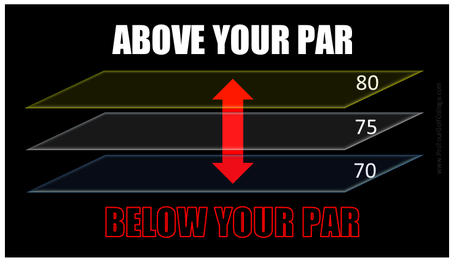 So what are the habits that really make the difference and that will help you to break your par more often? When I talk about breaking par here I’m not talking about the par of your golf course necessarily, what I’m actually talking about is your best scores over a year. It’s about breaking your par. We have found that an advanced or elite golfers score range is within 10 to 12 strokes of their best score so a good amateur golfer who has a score average of 75 will likely have a high score average of around 80 (when they are not playing their best) and a low score average of around 70 when they are playing their best golf. So your below par score is the score that is lower than your average score, so it could be a 70 is your par breaking score when your average score is 75. Or it could be that 68 or 69 is your par breaking score when your average score is 73. Or it might even be an 80 when your score average is 85. For professional tour golfers their low score average will be 3 to 5 strokes lower than their score average and their high score average is likely to be 3 to 5 strokes higher than their score average, So breaking your par more often is all about getting the absolute most out of your golf practice the skills and by developing the 7 habits that you are going to learn about today this will be easier for you to do more often. 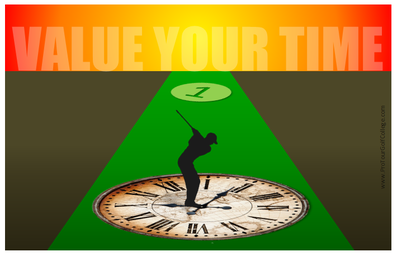 Your Par Breaking Habit Number 1. Put a Higher Value on Your Practice Time Golfers who get more done and make more progress in their game all have one thing in common. They value the time they have available to them on the practice fairway more than other golfers. This habit is at the very top of the list because it is the most important of all. All you have to work with is time, and since it is something that you cannot save for another day the way you manage your time on a daily basis is the primary key to your success at golf and so I want you to remember this; “You don’t have all the time in the world to get good at golf; you have the same amount of time as everyone else.” 1,440 Minutes and Counting Down...Tick...Tick...Tick... You have 1,440 minutes in every day and if you think about each minute as a valuable gold coin that vanishes once the minute expires you can see that those 1,440 minutes each day are cutting into the available time you have allocated to work on your game. Your gold pile goes down every day by the same amount day-after-day and like I said there's no saving your coins for another day. Ten minutes of 'chat time' with someone costs you 10 gold coins. How many coins have you spent not practicing when you should have been in the last week?... You can’t waste one moment of any practice session and yet it amazes me how often I see really good golfers (even pro’s) just standing around talking on the range (or checking their texts) when they should be focused and working on their skills. They give me the impression that they have all the time in the world to get good at their craft. This is not true; you don’t have all the time in the world to get good at your craft and golf success won’t wait for you, it will leave you behind. Do you like giving away your precious gold coins to others. How does that benefit you? The first habit you need to cultivate is the habit of managing the time you allocate to your golf practice and ruthlessly protecting it. You need to determine how much time each day you will spend on the practice ground, and on the golf course, and you need to make sure that you never compromise on this. The way you manage your time and how important time is to you determines to a great extent how good you will be at golf. 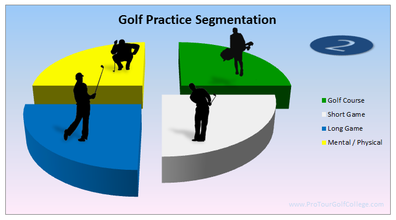 Your Par Breaking Habit Number 2. Segment Your Practice Time The next important par breaking habit is to segment or divide your practice time so you can work on each of the golf skills you have to improve As there are many skills that need your attention so you need to determine how much time you will spend on these skills during a week of practice. The first thing to do is work out how much practice time you will "spend" on the range and how much time you will "spend" on the golf course over a week. If you work, go to school, or you are a tour player, you will build your practice plan around your available hours from Monday to Sunday by creating a plan that incorporates the available hours you are practicing. For example how many total hours will you spend practicing this upcoming week? _____ And keep in mind that your schedule will allocate time for these 4 areas of your game;
Can you answer the following 4 questions easily?
These are important questions that you should be able to answer quite easily. Your second par breaking habit is to allocate time to practice your golf skills before you go to the practice ground or golf course. Don’t just turn up and figure it out from there like the great majority of golfers do. Plan it first, and then practice it.  Click on the image to make it larger Click on the image to make it larger Your Par Breaking Habit Number 3. Practice Your Weakest-Most Important Skills First You might be thinking that you have a certain amount of practice time already allocated to improving your golf skills but how do you know what to work on? Good question, you do need to know what to work on and this is the challenge that many advanced and elite golfers face of not knowing what to practice out of all the skills they need to practice. 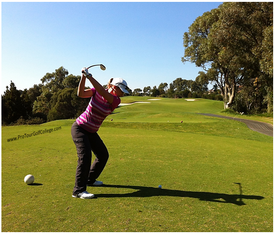 To perform a simple golf course playing assessment go out onto the golf course with your golf instructor so he/she can observe how you play golf and use your skills to produce scores. Quite often your golf instructor can see things about the way you create your scores on each hole that you won’t notice. Isolate 1 or 2 skills or strategies that you know if improved will help you to lower your golf scores on the course in tournaments. To perform an assessment on the practice ground hit 10 sets of 10 golf shots from 10 different locations around the green and notice which skills you have more trouble with. Set yourself a target of getting 7 shots out of 10 within 6 feet (2 metres) of the hole. Do you struggle to hit high and soft lob shots to tight pin placements making it harder to save par? Or maybe your bunker shot to a tight pin gives you trouble. If you score below 50 percent in any of these skills and you know that these are skills that you are certain would help you to break your par then you need to target these skills first. To assess you mental skills there are a number of excellent mental profiles that cost very little to purchase and will definitely help you to understand your mental game more and show you where you can make progress in this important area of your game.
Set yourself a target of getting 7 shots out of 10 within 6 feet (2 metres) of the hole. Do you struggle to hit high and soft lob shots to tight pin placements making it harder to save par? Or maybe your bunker shot to a tight pin gives you trouble. If you score below 50 percent in any of these skills and you know that these are skills that you are certain would help you to break your par then you need to target these skills first. Assessing Your Mental and Physical Skills Check out the Mental Golf Workshop at this link http://www.mentalgolfworkshop.com/app/default.aspx and use our student access code procollege to assess you mental game. You get a 28 page comprehensive report of your mental skills and strategies for how to improve them and this is the one we use with all our students at Pro Tour Golf College. To assess the physical part of your game we highly recommend you see a qualified golf fitness professional and by going to this link http://www.mytpi.com/experts you can type in your zip code or location and find a golf fitness professional that is golf specific and accredited with the Titleist Performance Institute (T.P.I.) Now choose just 3 to 6 skills out of the 4 categories that you know are influencing your higher scores the most and spend more time each week working on these skills until they become strengths in your game.
"When you focus your discussion with yourself and your caddy on the present moment you can rapidly regain control of your emotions and make more clear decisions." Great players have the ability to bounce back from making mistakes during a round, or from disappointing performances during important tournaments. Developing and maintaining a positive approach to dealing with errors plays a crucial role in your success. A Negative Approach to Mistakes: Coaches and Caddies alike, talk to me about the frustration they experience when watching their players make errors on the course, and then psychologically beat-themselves up. These players focus on the mistake, continue to talk about it on the 12th tee when the error occurred on the 9th green. These players become unfocused on what is important: the next shot. Negative and unproductive thoughts allow doubt to creep in, confidence can plummet, and performance deteriorates. As a result, players who respond to mistakes in negative ways seldom reach their full potential. 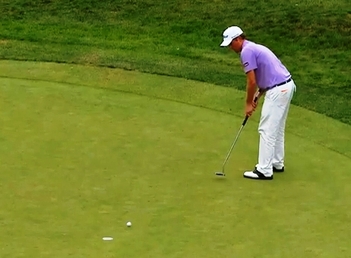 The Bounce Back Factor: A positive approach to mistakes is first built on a foundation of acceptance that mistakes are inevitable and a realization that the mistake is not permanent and can be changed or rectified. A positive approach to mistakes is NOT about being satisfied or accepting less than your best, it’s a productive approach where players realize golf is a game involving errors, and winners are those players who bounce back quickly and consistently. The goal is to learn from the errors and move on. Developing a positive response to mistakes: Developing a positive response to mistakes often requires more than just re-directing your attention and “forgetting about it.” To be truly effective in your attempts to bounce back you must develop an action plan that includes both key thoughts and actions. Positive Response in Thought and Discussion: 1. Refocus Cues: First create a guiding attitude you want to live by as a player: An attitude that is based on adaptability and intensity when things aren’t going well, and does not accept quitting or feeling sorry for yourself. Then come up with one or two words that sums up this attitude for you as a mission statement such as, “stay hungry”, “never quit”, or “love the battle.” Use these words as Refocus Cues when you experience adversity on the course and stop the negative responses cascading out of control. 2. Productive self-talk and conversations with others: Review the type of conversation you have with yourself and with your caddy or coach when you make poor mistakes during a round. Some players can get more openly negative when they have some one there to complain to such as their caddy or coach, compared to times when they are alone on the course. This type of action must be controlled. You have to practice discipline in what you chose to talk about. Your discussion can be reactive and maintain your focus in the past and on how frustrated you feel, or it can be proactive and focus on the “task at hand”. 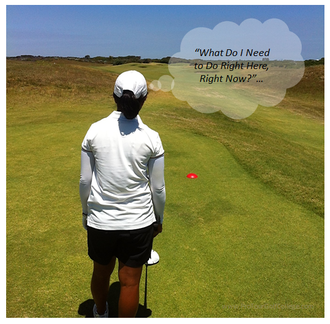 An effective approach to creating a proactive discussion is to ask yourself, “What is my plan for this next shot?”, “What do I need to do right here, right now?” Think and Do. When you focus your discussion with yourself and your caddy on the present moment you can rapidly regain control of your emotions and make more clear decisions. Positive Responses in Action: Body Language: Altering your body language or walk can be a highly effective way to reverse negative emotional reactions. Most players do not place enough weight on how powerful this type of action can be. For instance, if you are the type of player who starts to rush your walk and looks down in thought after a few errors this can translate to rushed pre-shot routines and fast swings. To reverse this chain-reaction, you might need to slow the pace of your walk, look up and out at the course, and stretch to reduce the tension you feel. Recognizing the type of switch you need to create is an important step and everyone has slightly different needs. Leave the error behind you: Following a frustrating 3-putt or a really poor shot that has left you in trouble, most players walk on from these errors too quickly still carrying the mistake with them as they move to the next shot. Create an action that helps you to leave the mistake behind. For example, take a moment to visualize the shot you wanted to see, and then let it be. Make a commitment to placing your club back into your bag only after you have assessed why you made the error and are ready to move on. Do not place the club back into the bag until you can let it go. Plan your positive approach to mistakes: All of these strategies seem easy enough to do, but if you do not plan specifically the key thoughts and actions you will engage, they won’t suddenly take shape when adversity strikes, and your default reactions are likely to take over. Select at least ONE key thought and action as your “go to plan”, and then share it with your coach or caddy. Sharing your positive reaction plan will allow your supporters to provide feedback on how well you are responding in accordance with your plan, particularly the body language changes. Sharing the plan with others also enhances your accountability; in fact we are all better at following through with our plans when we know we are being monitored. Dr Jay-Lee Longbottom Book an appointment to further develop your positive approach to mistakes with Dr Jay-Lee at the Singapore Sports Medicine Centre. With this Easy to Learn Method You Can Take Your Game Into the Low Golf Score Zone More Often17/5/2014
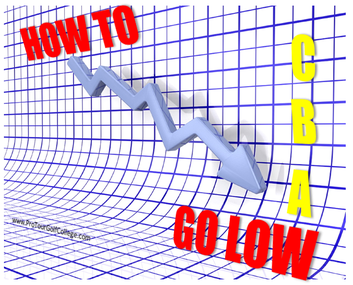 There’s no doubt that over the past three decades the scoring average of tour players has dropped and many more professional golfers are raising the bar and producing scores that years ago only a very small percentage of the field at a pro tournaments would shoot. A combination of improved golf equipment, better maintained golf courses, improved golf instruction and better practice methods has made a big difference to the game at the elite end of the scale. Furthermore there are a lot more golfers from a lot more places around the globe playing golf for a living and these factors all come together to where we see stronger competition driving the scores down each week in tournaments. But here's the reality of competition still, those that have developed the ability to score lower more often have the advantage in every tournament they play in. This was a fact of competitive golf 3 decades ago and is still the case today. All successful professional golfers have developed the Go Low ability.
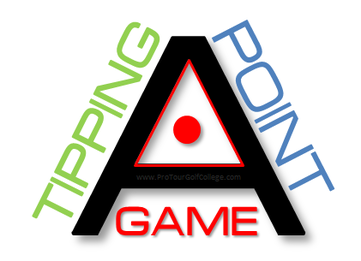 The Tipping Point Into the A Game Zone Here’s a quick question for you; “do you find it easier to play in the A Game Zone or harder?” In other words when you are playing your very best doesn’t it seem easier? Less mental and physical effort is required to play your best and contrast that when you are playing poorly and I bet it seems like you are working a lot harder and your score average for the round is higher. Small actions can have a huge impact on your golf scores like the old saying goes; “big doors swing on small hinges.” This simply means that quite often it is the little things (like a change in attitude or perspective) that you do during a round that can and often do lead to much bigger and better performances. Study our golf score tipping point model (below) for a moment and notice how the red dial is constantly moving up and down responding to the playing performance frequency (green dotted line). As golf scores move up and down (and they do for every golfer) the behavior is similar to a frequency that is being affected by external forces. The red dial is responding to physical and mental effort from the golfer and you can clearly see that when mental and physical effort is lower - that is when you are not trying so hard, the golf scores are lower. Conversely when more effort is applied to produce low scores, it forces the dial up towards the high score average. Now it is absolutely normal for the dial to be moving up and down but the aim should always be to reduce the high score average and lower the low score average, which is exactly what Steve Stricker did in the 2013 season. Trying to do something (like playing golf shots) implies that you cannot do it (you are trying to do it but not doing it). How many times do you use the word try to describe your effort to play golf shots or produce scores? Trying to play golf and playing golf are diametrically opposed methods. TRYING --------------------------------------------------------------------------------------------------------------------------------- PLAYING Imagine how the dial would respond to Steve Strickers game, can you imagine that the dial would bounce gently from A to B mostly and hardly ever be bouncing up into the C Game Zone? His mental / physical effort would move within the low to moderate effort and the frequency that this effort produces (green dotted line) would be smaller. Why Force What Should Be Allowed? Elite golfers who have learned many of their golf skills to the unconscious competence or autonomous stage need to understand that at this level you allow your golf skills to perform - you don't try to make them perform. Applying extra effort does not give you access to the A Game Zone, it will keep your score average higher than it should be and it quite often leads to frustration and poor decisions, and also confuses you about the future direction you should take your game. The idea behind this is quite simple; at some point of time in your development you should expect your effort to produce lower scores to reduce whilst at the same time you should experience the benefit of an increase in performance, which should translate into lower score averages. When you have practiced your golf skills for many hours over a period of years you must come to the realization that your golf skills are there to support you, and that they will support you if you let them. You no longer have to help or force them to operate, you simply allow them to work for you. So how do you teach yourself to let go and just play? 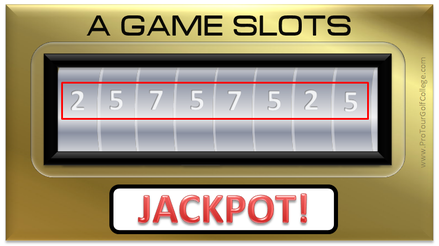 The Code for Getting Into the A Game Zone I'm going to share with you something that is very simple to understand that will explain why elite golfers rarely get out of their B and C games into the A Game Zone. Imagine that your A Game is locked away in a slot machine and you need the right code to unlock it giving you access to the A Game Zone. The trouble is sometimes you can access it and play in the A Game Zone but you never seem to remember what the code was for accessing it, and it frustrates you because you know that you should be playing there more often. Remember I said earlier that you have more than likely developed your skills enough to get into the A Game Zone more often but that you discover that anytime you look like going there you find a way to play outside of it. Let me say it again; trying won't give you access to the A Game Zone. You have to play shots - not try to play shots, and you have to play golf and not try to play golf. We teach our students a simple code and the philosophy behind it to explain why some golfers find it hard to get into the zone and the understanding you need to unlock your average game so you can get there more often. Here's the code that will unlock it for you; 25/75 - 75/25 The 25/75 Rule The 25/75 Rule teaches us that just 1 golf shot out of 4 (25%) from greater than 100 yards is likely to turn out as you expected it, and 75 percent of your shots won't. Any golf shot you hit can just as easily be hit left, right, short or long as opposed to being hit the way you expected. This rule also says that 1 round out of 4 you will play to your expectations. Golf is a hard game because expectations far outweigh ability on the golf course. The greatest golfers of all time know this and accept this, which doesn't mean that they don't do their best on every shot, no it just means that they know the reality of hitting shots into greens on the golf course is nothing like hitting shots on the range. The way many golfers practice at driving ranges teaches us the wrong lesson about learning and playing golf. Driving ranges with their wide open spaces teach us that golf is easy because if we hit poor shots we can always hit many more to improve the result. Elite golfers often get sucked into the illusion that they believe they should be hitting mostly perfect golf shots to play well because they are very likely hitting a high percentage of shots to their expectations on the driving range. Unfortunately this type of practice is performed with little to no pressure, where you are conditioning your nervous system to repeat an action without continually introducing additional stress much like what you are likely to face on the golf course. The Context Changes the Meaning Can you see the problem when you hit lots of shots free from stress - or with much less than you face on the golf course? When you go to the course and have to hit one golf shot your expectations rise and because you haven't been practicing to hit one golf shot with the right level of focus you are more likely to fail to hit the shot the way you want. The context (environment) is different when you practice on a golf range compared to when you play on the golf course as they mean different things to you. One seems relatively easy to do and the other seems relatively hard to do. You see you have very different maps or mental models for practicing golf to playing golf. The rules are different and so the reality-your reality is different for both. By applying the 75/25 Rule to longer approach shots and accepting that in all likelihood just 1 shot out of 4 will be to your expectations your reduce the pressure to try to hit perfect golf shots and are more likely to achieve better results that are actually closer to your expectations. In other words you are more likely to stay out of our own way and just play shots, and just play golf, and you will set yourself up to visit the A Game Zone more often. 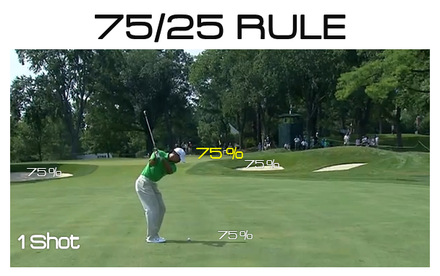 The 75/25 Rule The 75/25 Rule says that 3 out of 4 recovery / scrambling shots will turn out as expected when you miss greens in regulation. This is the 'game' part of golf where you have to play shots that translate into par scores, as par is the standard of a golf hole. Because these types of strokes are the shortest they are also easier to play compared to full shots. So the expectation is flipped to where you know that the probability is high that you will make par or better from the situation. Yes the pressure is a little higher than the approach game however this is the reality of A Game golf, you have to develop your scoring skills to where you know that you will consistently set-up scoring opportunities with your wedges and putter. This is the main reason Steve Stricker is able to keep his high score average down because he is very good at making pars when he misses greens inside 100 yards and this takes the pressure off his score making. He can get himself into the A Game Zone more often because he has the shots and developed ability to keep producing score saving shots. These score saving shots keep him out of the C Game Zone. Like every top class male and female golfer these golfers get into the A Game Zone more often because they do 2 things really well.
This doesn't mean you don't expect the best from yourself, of course you do, it simply means you know that you are more likely to miss your approach shots left, right, short or long and you accept it as part of the game. The other side of the coin is that you constantly develop your short-game shots inside 100 yards where you get to the stage where you truly believe that you will convert par 75 percent of the time.
"The trouble with the pursuit of a dream like this one is that too often emotions are dictating the decision about turning pro without recognizing the real cost of the decision." The time has finally come and you have decided that you want to play golf on a pro tour because you feel that have acquired enough experience playing amateur tournaments and you want to earn an income playing for pay in the pro ranks. That’s great, but how are you going to achieve this goal. Yes you have assessed the criteria and checked that your handicap is low enough to enter a tour school and now you want your chance to earn a tour card. The Rookie Review Process But are you really ready for this step up to the pro leagues? How do you know that you are ready? Are you a good enough golfer? How will you fund your venture? Have you been saving your pennies for a long time - or are your parents helping you to fund it? Or maybe you have a sponsor waiting in the wings? In today’s article we are going to help you to answer these questions by going through what we call "the rookie review process" which is a simple analysis that helps you to know up front the real cost of playing golf on a pro tour. So to start with we want you to imagine that you have to prepare a presentation for a potential sponsor who has expressed an interest in funding your tour quest for 1 year, and if you perform well enough she is willing to sponsor you for at least 2 more seasons. 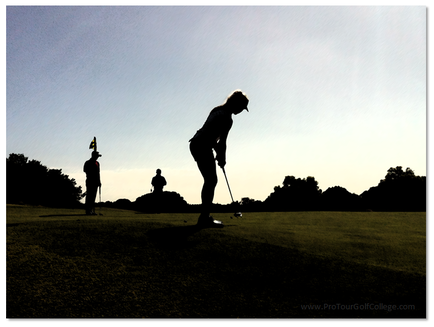 However this will only happen if you can convince her that you have the ability to generate sufficient income to pay her back. She has asked you to prepare a basic outline of costs associated with this venture to determine its viability, and once this has been completed you will present your findings. You have been asked to focus on four factors; 1. Calculate the full cost of competing on a major pro tour for a full season 2. Work out a daily budget for competing on tour 3. Determine the minimum playing standard for earning a consistent income 4. Determine the 'break even' number With this information it will be easier to determine whether this is a viable path to the pro tour, or for you to look at other options. Below you will see that we have presented a table describing a hypothetical situation where a young female golfer has gone through qualifying to get onto the 2013 Ladies European Tour (LET). We are going to look at the cost of playing on this tour with realistic budgets, and we will also determine the playing standard this golfer will require to break even on the tour. Best Case - Worst Case Scenario We want you to keep in mind that in the following example our hypothetical golfer makes every cut and earned the last place check in every event. We call this the best case-worst case scenario - Best case scenario is you make every cut (which is unlikely), and the worst case scenario - the golfer earns the last place check in every event (also unlikely). We are doing it this way to look at what this level of playing standard produces in terms of income generation. Below we have presented our Rookie Review, which is an analysis of the 2013 Ladies European Tour to show you the tour schedule, where the tournaments were located, and an analysis of tournament results with the score average for making every cut, and the score average for earning the last place check. The Rookie Review Process - Score AveragesSeparating Facts from Feelings We know that at some point of time ambitious amateur golfers want to go and try to play on a pro tour and we think this is wonderful opportunity for a really good amateur golfer to achieve this goal, and we wouldn't want to stop anyone from pursuing their dream if they have the drive to succeed, and more importantly the golf game to do it. The trouble with the pursuit of a dream like this one is that too often emotions are dictating the decision about turning pro without recognizing the real cost of the decision. This decision is always a business decision and you need to go through the numbers carefully to determine what it costs to do it properly and to work out if you have the game to succeed. What we mean by doing it properly is that you are not going to do it on the cheap and nasty where you stay in run down places and just scrape by, because this is never going to work and it will harm your professional development in the long run. In our example above the average par for the 19 tournaments was 71.54. If you average the total amount over par for making each cut and divide it by the amount of tournament rounds (61.5) you end up with a score average of 72.54. This average gives you some idea of the standard needed for making cuts in these events. Now to earn last money (after making the cut) you needed to score an average of 75.3 for the season. 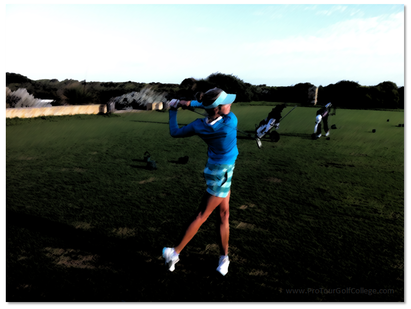 Working Out the Budget To determine the costs of doing business on tour you will need to do your homework to estimate how much it will cost for you to travel to tournaments, reside somewhere, eat and do all the other things you will need to do whilst on tour. I have worked out the cost of flying to the tournament locations for the season which is a relatively simple thing to do on the internet. I have estimated that airfares for the season would work out to be approximately $18,569 dollars (about 12,600 euros). In our hypothetical example we are working out the costs for a female golfer living in Perth, Western Australia who is going to play the entire season except for the invitational and qualifying events. We are going to establish a budget for the following: 1. Housing or accommodation 2. Meals 3. Others (general expenses) - i.e. caddy fee's, visa's, car rental and fuel costs, laundry, taxis etc We will not be looking at the tax implications of travelling and earning income in different countries as this is something you need professional advice on from a tax agent with experience in this specialized area.
It can be less than this once you have played for at least a season and you work out where the savings are as you are travelling from country to country, but it is always better to be safe than sorry, so build a budget around paying more than less for all the services you will require. The Rookie Review Process - The Daily BudgetDoing the Numbers OK, so let's take a closer look at what the numbers tell us. From our Rookie Review we can work out the viability of playing golf on the Ladies European Tour. Remember we started from a hypothetical situation of making every cut and earning last money in 19 events. Our rookie LET golfer after making a check in 19 events earned 17,402 euros or about 25,575 Australian dollars for being good enough to play in every event, make the cut and make a check. This would have ranked our golfer around 95th on the order of merit for the 2013 season. The Rookie Review Process - Profit and LossThe Profit and Loss - Reality Check Now that would be something for your first year on tour and that works out to about 1,353 Australian dollars income per week for the season. Here's the rub though; with expenses of about 3,710 Australian dollars per week we have a problem. Our expenses far outweigh our income and in her rookie season our golfer would have experienced a 53,099 dollar loss. Remember we are basing our earnings on making every cut and earning a check in every tournament which is the best case - worst case scenario. Of course a far more realistic scenario is that a very good amateur golfer will not make 100 percent of the cuts on tour in their rookie season. In fact with a score average of 72.5 our golfer would have missed a few cuts so the income would have been less but the expenses never are. The Break Even Point What about the break even point? Well, our golfer would need to rank about 46th on the 2013 money list (around 50 places better) to generate income of around 48,000 euros or 70,540.00 Australian dollars. As we always advise amateur golfers pursuing a pro tour career you have to do 2 things really well to become a successful golfer on any professional golf tour. 1. Make many more cuts than you miss 2. Make more money than you spend And this always gets down to your competitive score average which will need to be par or better to have any chance at all of becoming a successful professional golfer.
"Too often elite golfers focus much of their energy on improving technical competency without looking at whether they are strong enough in planning and strategic thinking and thoughts and emotions under pressure." 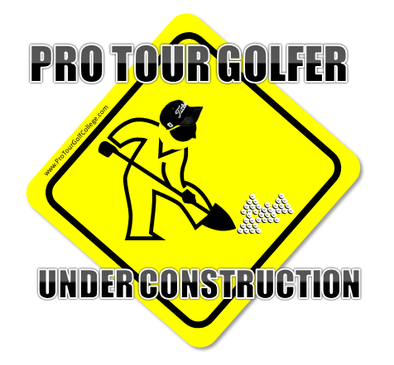 In my last article I showed you how to evaluate your 4 primary performance categories that will help you to identify, isolate and ultimately improve your golf skills so you can build and sustain competitive advantage on the pro tour. In today’s article I’m going to take it one step further by showing you how to dig much deeper into your game using some very simple and easy to use tools to isolate the specific sub category skills that will help you to score better and more consistently in tournaments. By now you have identified your weakest-most important performance category out of putting, short-game, approach shots and driving ranked them from 1 to 4. By evaluating these 4 categories with the help of the 3 primary resources of technical competency, tactical competency and temperamental competency (that influence every performance on the golf course) you can zero in on specific types of strokes that will drive your golf score average down. Unfortunately all too often elite golfers focus too much of their energy on just improving technical competency without looking at whether they are strong enough in planning and strategic thinking and thoughts and emotions under pressure. So to become a competitive force on a pro tour you will need to become excellent in all 3 resource areas because these key resources affect your playing and performance when it counts. How to Dig Deep to Discover the Gold in Your Game Let’s say that you have ranked putting as your weakest ability out of the 4 and you want to improve your putting performances in tournaments. Where would you start first, and how would you know what to work on? Well, any tour or serious amateur golfer that truly cares about their performances on the golf course and has a strong desire to get better will have up to date statistics on their putting performances from short putts to long putts and everything in between. Take a look at the image below and you can see the results for golfers ranked 90th on the PGA Tour for the 2013 season for putts ranging from 3 feet to 10 feet, and also 10 to 15 feet, 15 to 20 feet and 20 to 25 feet. I'm sure that you would agree that it certainly makes it easier to identify putting strengths and weaknesses when you can see your results in all these distance categories?
"What are your weakest-most important distances? These are the distances that when you improve them you increase your pars made average, your birdie or better average, and you decrease your bogey and worse average on tour." The Shot Tracking Scorecard Take a good look at our putt tracking scorecard below and notice in the example that our golfer has tracked his putts over 8 tournament rounds and bench-marked his putting performances against PGA Tour golfers who ranked 90th in distances from 3 feet to putts greater than 25 feet. Now admittedly you would sample more than 8 tournament rounds (12 or more is better), but for this example even with 8 rounds you can see how effective and simple it is to track and identify specific putting distances that you might be weak at with our shot tracking scorecard. The beauty of using this simple scorecard is that you are able to track different distances in your rounds to identify your strongest to weakest putt distances. Then you can compare or benchmark your results against players on the PGA Tour or another pro tour to see where you need to improve. Whenever you need to dig a little deeper into your game you simply bring out the scorecard and use it over 12 rounds to track your shots to find out whats going on. Statistical Relevance = More Pars and Birdies and Less Bogeys and Worse The key to improvement in the sub-skill categories is to identify the relevant statistics and then decide on the type of strokes you need to learn and/or improve that help you to make more pars and birdies and less bogeys and worse. We find that quite ironic when it comes to tour players compiling statistics that they often don’t see that improvement in a statistical category should increase their pars and better made percentage and reduce the bogeys and worse average. Its simply not enough to just improve a particular statistic (and hope you improve your score average) unless you can connect to an improvement in pars and birdies made etc. Take a look at the image below of our golfers short-game results over the same 8 tournament rounds and again you can see that we have very specific data on how effective this golfer is from a range of green-side distances out to 100 yards. Benchmark to Boost Results The bench-marks on the bottom of the scorecard are added so our golfer can not only track his results but also aim for a specific amount of improvement (within a defined time frame), and by doing this he knows how effective he is at getting the ball into the hole with his chip, pitch, lob and bunker shots from various distances in less strokes. All the bench-marks he has established are fractionally better than his current performances over the various distances, and with different types of strokes, and in the example we are looking for roughly 5 percent improvement - except when the result is zero where he aims at 20 percent. You can see how much better this approach is compared to just being able to say that you achieved a scrambling (stroke plus 1) result over 8 rounds of 50.7 percent. You will also notice that even where he has achieved 100 percent in a specific distance category, that he still bench-marks it based on the results that he wants to achieve over a longer period. For example he might be aiming to achieve a 20 percent improvement from 50 to 60 yards within 12 weeks even though he is currently at 100 percent, because he knows that 20 percent is more realistic in his first improvement phase. Track, Measure and Manage to Improve The best thing about tracking your shots on the golf course is that it takes away most of the guess work which makes it easier to work with your instructor or coach to plan for long-term improvement. How can you establish benchmarks if you don't know how good you truly are from one distance to the next? Unless I'm mistaken this game is built around distance and accuracy...You improve golf scores by improving the strokes that influence better scores. And it always gets down to the same things; improving your distance and direction control to improve your scores. Greens Hit in Regulation Tracking Greens hit in regulation in the approach shot category is another area where you might already know that your greens in regulation statistic is 52 percent for example but what you might not know is that your 180 to 195 yard range is weak (33.3%), and that you make more bogeys from this range than other distances. So let's say that you want to improve your 33.3 percent result and move it to your 40 percent benchmark in 3 months. By digging deeper into your results using the approach shot tracking scorecard you can isolate and then determine whether stroke competency is the problem, or possibly your strategy at this distance could be changed to help you to produce better results. Or maybe your stroke, strategy and confidence is fine but you simply don't practice this distance enough to improve it? Whatever you determine it to be you can now work on it more effectively with the help of your instructor to improve it. You Don't Drive For Show, You Drive For Results How about your tee-shot effectiveness, how good do you drive the ball from the tee? In the example below you can see that our golfer achieved a 64.3 percent result hitting his tee-shots into the fairway, but the best part of the analysis is not how many fairways he hit, but where his ball went when he missed the fairway. Our tee-shot tracking scorecard tracks the amount of distance the tee-shot misses the fairway by which will help you to identify where your high score average originates. Notice that of the 112 tee-shots he hit that 25 percent of his tee-shots went to the right and only 10 percent went left? You can also see that 14 of the tee-shots that went to the right are within 5 yards of the edge of the fairway, but another 14 missed between 5 and 20 yards further right which could mean that many of these shots were in deep rough or behind trees and making it more challenging to make pars and better, and it probably increased the likelihood of making bogeys and worse. Work On One Category at a Time I'm sure you are starting to see that it is much easier to understand and improve any area of your game when you track and measure your shots to manage your improvement. And keep in mind that you don't have to use all the scorecards at once because the idea is to work on one part of your game at a time - especially when you are playing tournaments because you have very little time to work on your game when you are on the road. It is better to compile the information whilst you are playing tournaments and then work on making the improvement when you get home where you have the time to work hard on the identified weaknesses away from distraction. Put your email address in the cell opposite the red arrow and press the "CLICK HERE" button and you will receive your links to your FREE tracking and training templates within 60 minutes.
|
Archives
June 2019
|
Proudly Supported By
Copyright © 2011 - 2018 Pro Tour Golf College
Website Managed By Golf Performance Media
All Rights Reserved
Website Managed By Golf Performance Media
All Rights Reserved

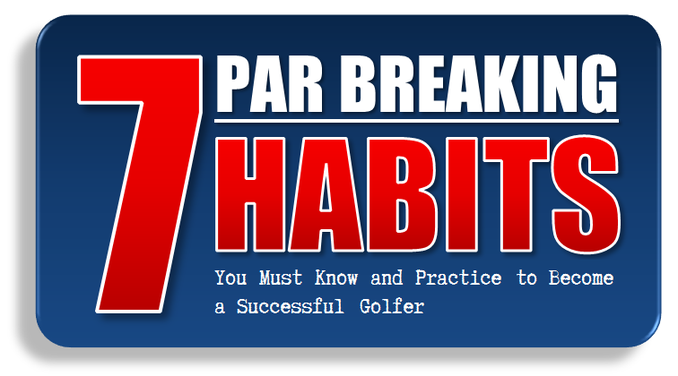




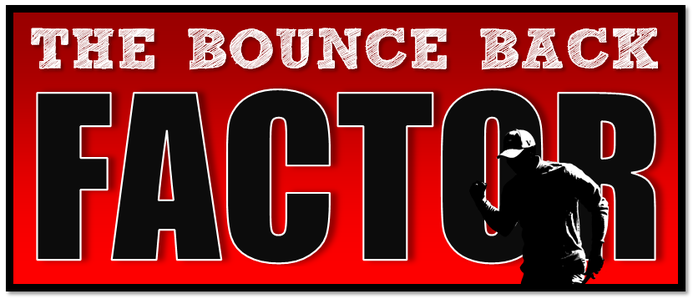
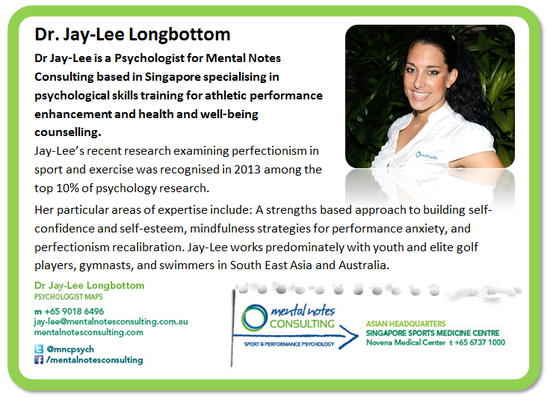

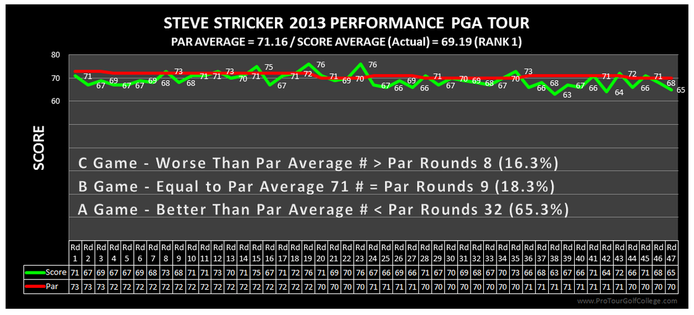
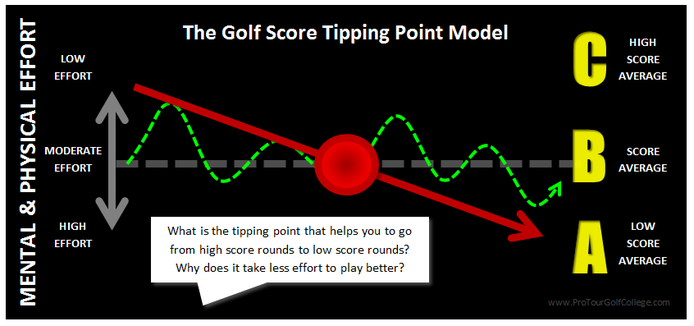
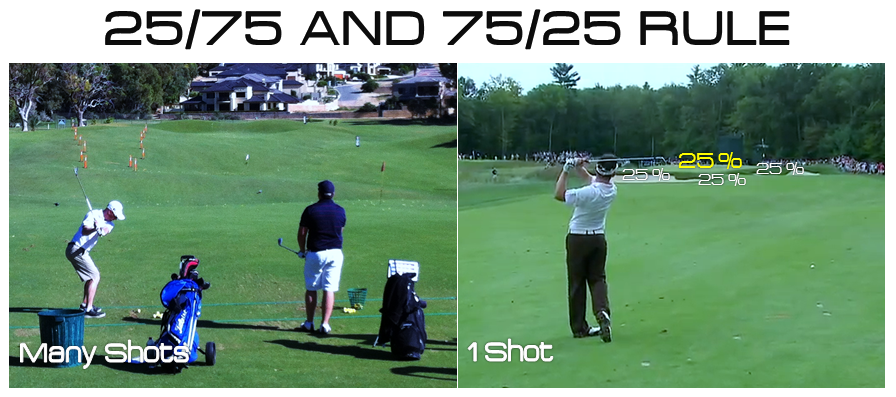



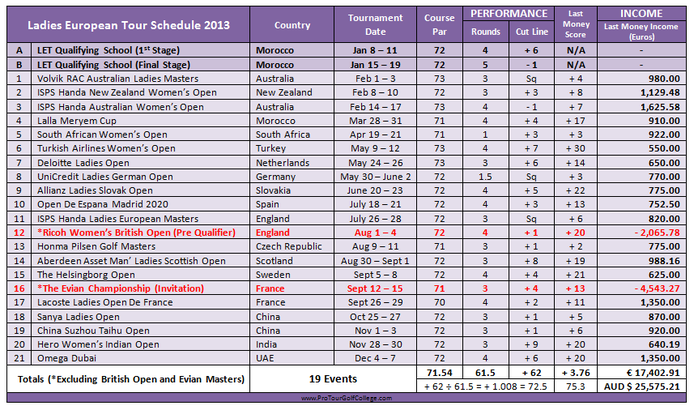

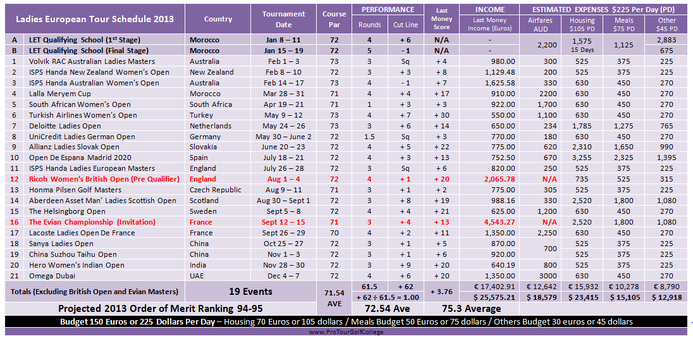
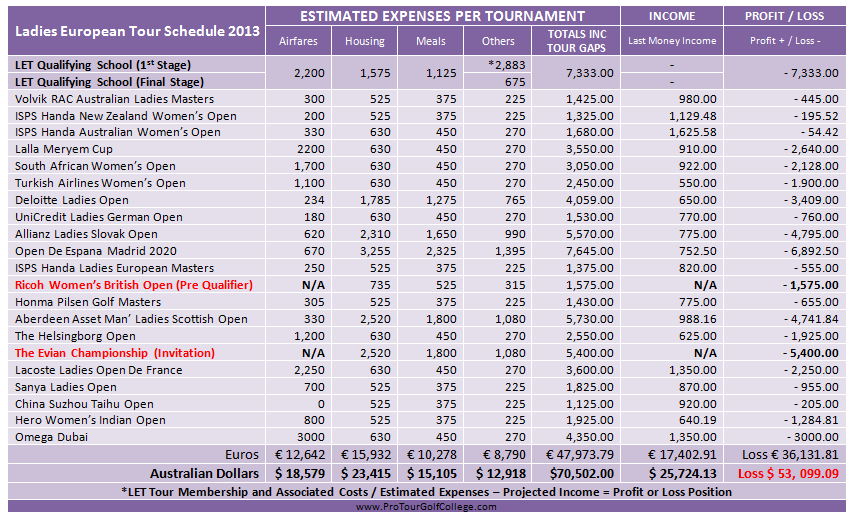

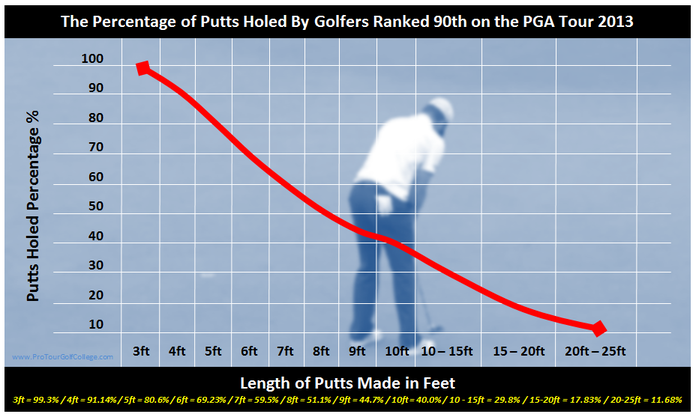

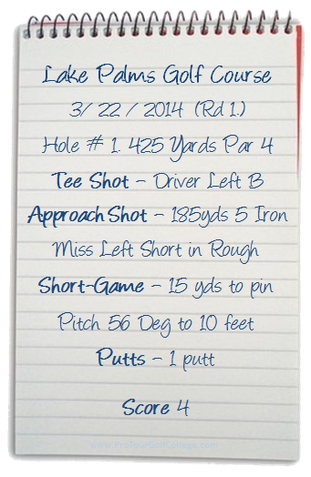
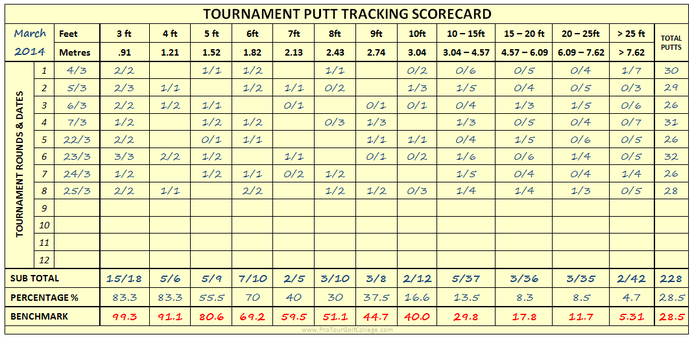
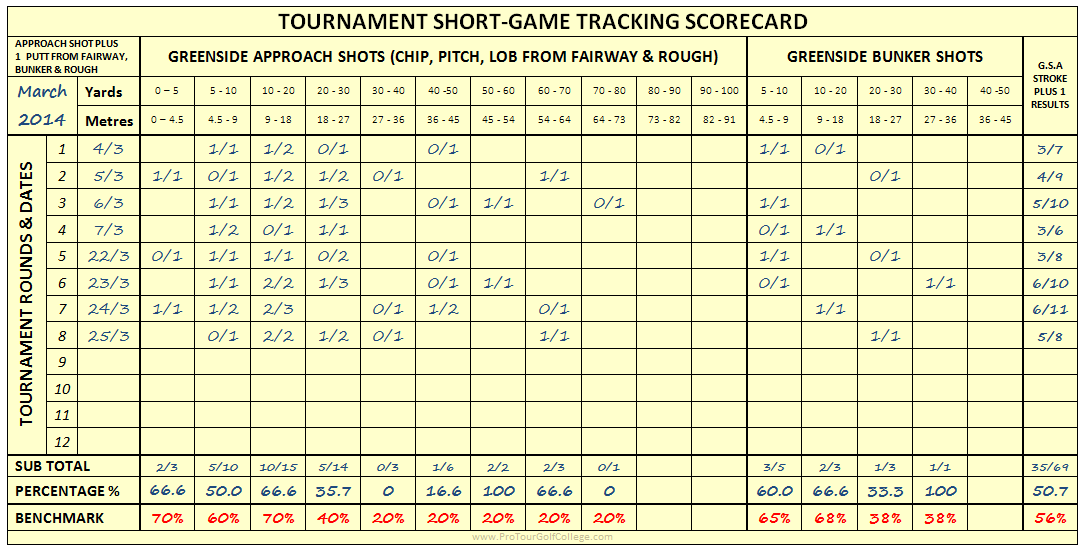
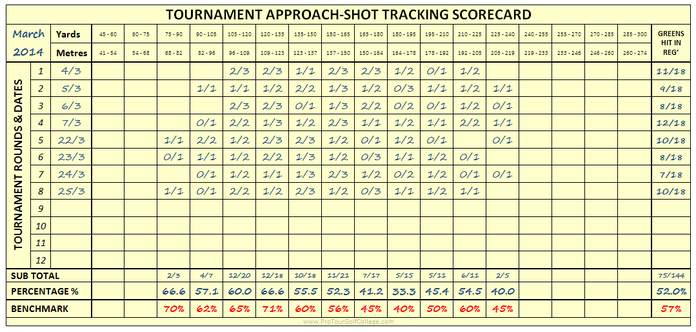
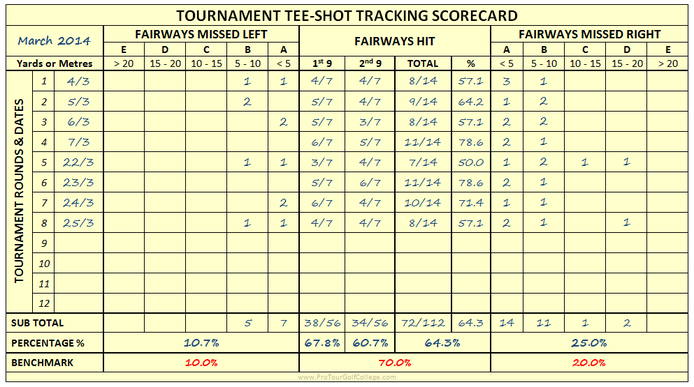
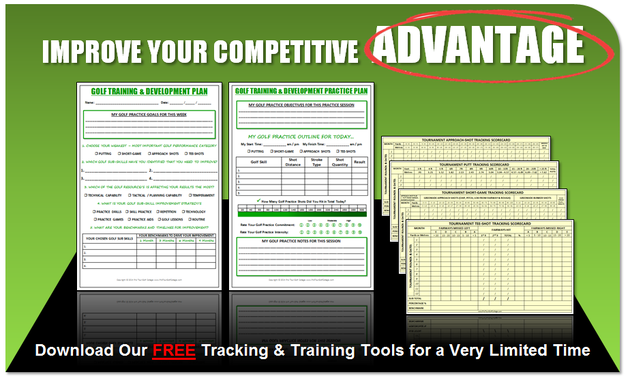


 RSS Feed
RSS Feed



